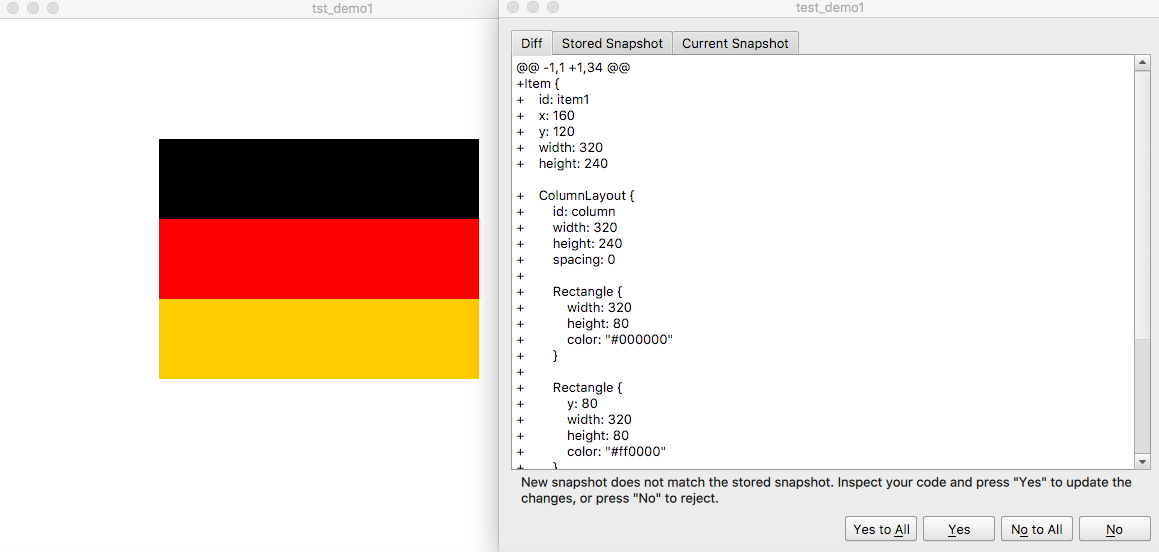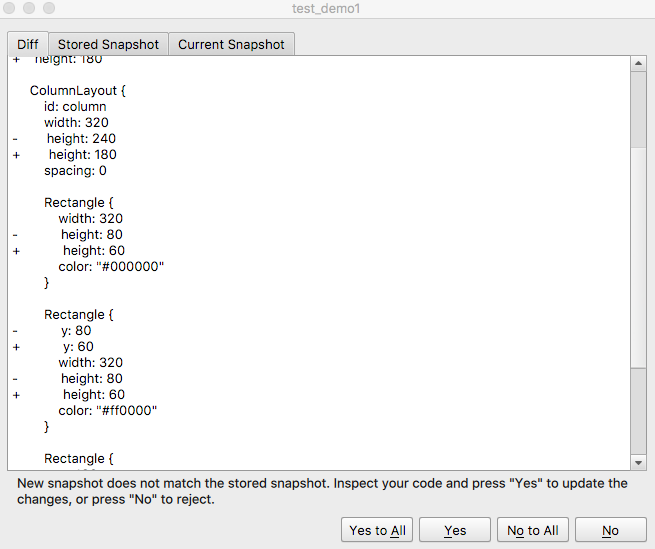This project is a library to offer snapshot testing for QML as a tool to make sure your UI does not change unexpectedly. It is inspired by Jest Snapshot Testing methodology.
Quoted from Snapshot Testing · Jest :
A typical snapshot test case for a mobile app renders a UI component, takes a screenshot, then compares it to a reference image stored alongside the test. The test will fail if the two images do not match: either the change is unexpected, or the screenshot needs to be updated to the new version of the UI component.
A similar approach can be taken when it comes to testing your React components. Instead of rendering the graphical UI, which would require building the entire app, you can use a test renderer to quickly generate a serializable value for your React tree.
The concept of this project is similar, but it replaces React component by a QObject/QQuickItem instance then convert to a text representation looks similar to QML. Then it compares with the previously stored snapshot. If the snapshots do not match, this library will prompt a dialog to ask the user for confirmation. If the changes are unexcepted, press "No" and will turn the test case fails. Otherwise, pressing "yes" will update the snapshot according to the latest version of the UI component.
Let’s see a demonstration:
// tst_Demo1.qml
import QtQuick 2.0
import QtTest 1.0
import SnapshotTesting 1.0
Item {
id: root
width: 640
height: 480
CustomItem {
// Don't place this under TestCase object.
id: item1
width: 320
height: 240
anchors.centerIn: parent
}
TestCase {
name: "Demo1"
when: windowShown
function test_demo1() {
var snapshot = SnapshotTesting.capture(item1); // Capture "item1" into a text representation
snapshot = snapshot.replace(Qt.resolvedUrl(".."), "");
SnapshotTesting.matchStoredSnapshot("test_demo1", snapshot); // Compare with previously stored snapshot
}
}
}// CustomItem.qml
import QtQuick 2.0
import QtQuick.Layouts 1.3
Item {
ColumnLayout {
id: column
anchors.fill: parent
spacing: 0
Rectangle {
Layout.fillHeight: true
Layout.fillWidth: true
color: "#000000"
}
Rectangle {
Layout.fillHeight: true
Layout.fillWidth: true
color: "#FF0000"
}
Rectangle {
Layout.fillHeight: true
Layout.fillWidth: true
color: "#FFCC00"
}
}
}In the first time execution, it has no any previously saved snapshot. It will prompt a UI and ask for confirmation of applying the changes to snapshotsFile by the SnapshotTesting.matchStoredSnapshot function.
If you press "No", it will throw an exception to let the test case fails. You should press "Yes" and the snaphosts will be stored.
Once the snapshots file is created, this UI will not prompt again unless there have changed. For example, if it modify item height from 320 to 180. And run the porgramme again. It will show:
SnapshotTesting converts a QObject/QQuickItem to a text representation like QML. But it will remove all the data binding/anchors and show the real coordination information. It will also remove non-visible items by default. In case you wish to show non-visual component in your snapshot. You should pass captureVisibleItemOnly to false in the capture() call.
var snapshot = SnapshotTesting.capture(item, {captureVisibleItemOnly: false });
Quoted from :The Five Key Mindsets to Master If You Want to Be a Successful Programmer
Or suppose that you’re fixing a bug that requires you to start the app and then navigate through five screens to set up the right conditions to trigger the bug. Could you spend 10 minutes to wire it up so that it goes to the buggy screen on startup?
The debugging technique mentioned above is very useful. But there has a problem. How do you manage the code of short cut? If it is not saved in version control, then you have to patch your code for every time you found a new bug.
However, it is quite difficult to put the short cut code in your application. It will add a lot of #ifdef condition that you don’t want to handle it.
The best place to hold the code is the unit test problem with using SnapshotTesting. You could simulate a specific condition with chosen UI component. The “SnapshotTesting.matchStoredSnapshot()” will only pause the test case but not the UI. So you could evaluate your UI until you have pressed “Yes” to confirm the behaviour.
This kind of technique has no name. Personally, I would call it as gallery tests. As it will collects a set of UI in different condition finally.
qpm install net.efever.snapshottesting
An example program is available in the examples folder within the source code.
SnapshotTesting.snapshotsFile[Property]
It is a property to hold the file to save/load snapshots. It is recommended to set this property in main.cpp by the C++ API
String SnapshotTesting.capture(object, options)
This function will capture the data of input object, then convert to a text representation similar to QML. The result truncates data binding/anchors, it will only show visible items and actual values.
Options
- captureVisibleItemOnly - If this value is set to true, it will only capture visible items. [Default: true]
- expandAll - By default, the capture function only captures item in the context of the input object. Set this to true will expand all the nodes. [Default false]
- hideId - If this value is set to true, it will not show the "id" field in the captured snapshot.
SnapshotTesting.matchStoredSnapshot(name, snapshot)
Compare the input snapshot to the previously stored snapshot with the name. If they do not match, it will prompt a dialog to ask for updates or not. If user press "no", it will throw an exception to let the test fails. You should press "Yes" to get the stored snapshot be updated.
Header
#include <snapshottesting.h>void SnapshotTesting::setSnapshotsFile(const QString &file) [static]
Set the snapshot file to be saved.
void SnapshotTesting::setInteractiveEnabled(bool value) [static]If it is set to false, it won't prompt the GUI matcher even the snapshot is not matched.
Should snapshots file be committed?
Yes.
Does snapshot testing substitute unit testing?
How do I resolve the conflict within snapshots file?

